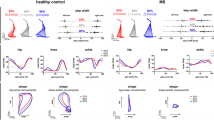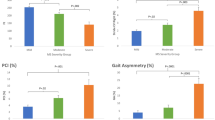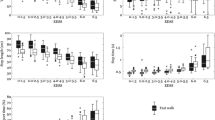Abstract
Walking deterioration is a common problem in people with multiple sclerosis (PwMS). However, there are only scarce data examining the contribution of specific neurological functional systems on gait performance in multiple sclerosis (MS). Therefore, the objective of the current study was to examine the differences in spatio-temporal parameters of gait according to the pyramidal, cerebellar and sensory functional systems. The cross-sectional study included 289 PwMS with mean disease duration of 8.0 (SD = 8.2) years. Spatio-temporal parameters of gait were studied using an electronic walkway. The sample pool was divided into six groups according to the scores of the pyramidal, cerebellar and sensory functional systems, derived from the expanded disability status scale data. Findings indicated that asymmetry of the step time and asymmetry of the single support were significantly elevated in the pyramidal group compared to the sensory group; 9.4 (SD = 10.6) vs. 3.1 (SD = 6.7), P value = 0.004; 9.3 (SD = 10.4) vs. 2.7 (2.1), P value = 0.001, respectively. Additionally, patients in the pure sensory group walked significantly faster with longer strides and less asymmetry compared to the pyramidal–cerebellar–sensory group. Moreover, patients in the sensory group walked with longer steps/strides and symmetry compared to the patients in the pyramidal–cerebellar group. This study confirms that pyramidal disorders are main contributors of gait impairments in the MS population. Furthermore, patients with sensory impairments have a relatively preserved gait pattern compared to patients affected by the pyramidal system.



Similar content being viewed by others
References
Weinshenker BG (1995) The natural history of multiple sclerosis. Neurol Clin 13:119–146
Kister I, Chamot E, Salter AR, Cutter GR, Bacon TE, Herbert J (2013) Disability in multiple sclerosis: a reference for patients and clinicians. Neurology 80:1018–1024
Lizrova Preiningerova J, Novotna K, Rusz J, Sucha L, Ruzicka E, Havrodova E (2015) Spatial and temporal characteristics of gait as outcome measures in multiple sclerosis (EDSS 0 to 6.5). J Neuroeng Rehabil 12:14
Pilutti LA, Dlugonski D, Sandroff BM, Suh Y, Pula JH, Sosnoff JJ, Motl RW (2013) Gait and six-minute walk performance in persons with multiple sclerosis. J Neurol Sci 334:72–76
Huisinga JM, Schmid KK, Filipi ML, Stergiou N (2013) Gait mechanics are different between healthy controls and patients with multiple sclerosis. J Appl Biomech 29:303–311
Kalron A (2016) Gait variability across the disability spectrum in people with multiple sclerosis. J Neurol Sci 361:1–6
Cameron MH, Wagner JM (2011) Gait abnormalities in multiple sclerosis: pathogenesis, evaluation, and advances in treatment. Curr Neurol Neurosci Rep 11:507–515
Kalron A, Achiron A, Dvir Z (2011) Muscular and gait abnormalities in persons with early onset multiple sclerosis. J Neurol Phys Ther 35:164–169
Thoumie P, Lamotte D, Cantalloube S, Faucher M, Amarenco C (2005) Motor determinants of gait in 100 ambulatory patients with multiple sclerosis. Mult Scler 11:485–491
Martin CL, Phillips BA, Klipatrick TJ, Butzkueven H, Tubridy N, McDonald E, Galea MP (2006) Gait and balance impairment in early multiple sclerosis in the absence of clinical disability. Mult Scler 12:620–628
Givon U, Zeilig G, Achiron A (2009) Gait analysis in multiple sclerosis: characterization of temporal-spatial parameters using GAITRite functional ambulation system. Gait Posture 29:138–142
Kalron A, Frid L (2015) The “butterfly diagram”: a gait marker for neurological and cerebellar impairment in people with multiple sclerosis. J Neurol Sci 358:92–100
Polman CH, Reingold SC, Banwell B, Clanet M, Cohen JA, Fillippi M et al (2011) Diagnostic criteria for multiple sclerosis: 2010 revisions to the McDonald criteria. Ann Neurol 69:292–302
Kurtzke JF (1983) Rating neurologic impairment in multiple sclerosis: an Expanded Disability Status Scale (EDSS). Neurology 33:1444–1452
Gage JR, Schwartz MH (2009) Normal gait. In: Gage JR, Schwartz MH, Koop SE, Novacheck TF (eds) The identification and treatment of gait problems in cerebral palsy. Mac Keith Press, London, p 40
Pau M, Coghe G, Corona F, Marrosu MG, Cocco E (2015) Effect of spasticity on kinematics of gait and muscular activation in people with multiple sclerosis. J Neurol Sci 358:339–344
Chung LH, Remelius JG, Van Emmerik REA, Kent-Braun JA (2008) Leg power asymmetry and postural control in women with multiple sclerosis. Med Sci Sports Exerc 40:1717–1724
Usynski M, Purtill H, Coote S (2015) Relationship between foot vibration threshold and walking and balance functions in people with multiple sclerosis (PwMS). Gait Posture 41:228–232
Newsome SD, Wang JI, Kang JY, Calabresi PA, Zackowski KM (2011) Quantitative measures detect sensory and motor impairments in multiple sclerosis. J Neurol Sci 305:103–111
Acknowledgments
The author thanks Mrs. Phyllis Curchack Kornspan for her editorial services.
Author information
Authors and Affiliations
Corresponding author
Ethics declarations
Ethical standard
The study was approved by the Sheba Hospital Research Ethics Committee (Ethics Ref: 5596-08/141210).
Conflicts of interest
The authors declare that they have no conflict of interest.
Rights and permissions
About this article
Cite this article
Kalron, A., Givon, U. Gait characteristics according to pyramidal, sensory and cerebellar EDSS subcategories in people with multiple sclerosis. J Neurol 263, 1796–1801 (2016). https://doi.org/10.1007/s00415-016-8200-6
Received:
Revised:
Accepted:
Published:
Issue Date:
DOI: https://doi.org/10.1007/s00415-016-8200-6




